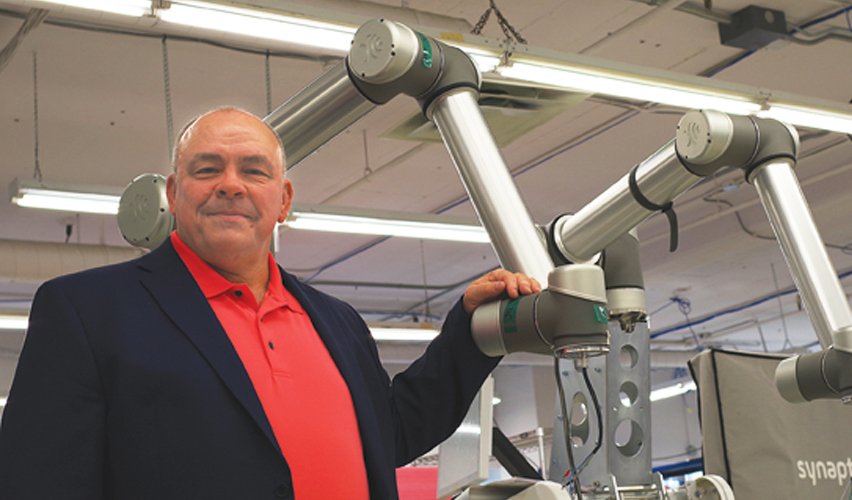Feature Story

Toronto’s Synaptive Medical innovates in neuro MRI and surgical imaging
October 31, 2023
TORONTO – Most diagnostic imaging and surgical equipment is imported into Canada from the United States and abroad. But one Canadian company is bucking the trend, and it’s manufacturing its own MRI scanner and robotic neurosurgical technology right in the heart of downtown Toronto.
Synaptive Medical has designed and produces a mid-field 0.50T MRI that’s optimized for brain scans. It has now installed units at the QE II Health Sciences Centre in Halifax, the Toronto Western Hospital and the Toronto General Hospital, both part of the University Health Network, and has an installation pending at Sunnybrook Health Sciences, in Toronto.
As well, it has deployed one of its MRIs on the 16th floor of a private health clinic in Toronto.
While the Synaptive MRI is smaller than traditional scanners and aimed solely at neurological exams, the company is strategically situated on the cusp of a brain-exam marketplace that is rapidly growing. Neurologists and neurosurgeons – as well as ER departments – have started to order many more brain exams.
And that puts Canada’s Synaptive Medical in an enviable position: it hopes to meet the demand with a scanner that offers images it claims are as good as those produced by traditional, 1.5T MRI scanners. In some cases, the Synaptive scanner’s results are even better.
“The contrast between white and grey matter in the brain is better at lower field strength,” said Alex Panther, vice president of R&D for MRI.
“You also have less distortion in the borders between structures,” he added, such as the brain and parts of the inner ear, such as the ear canal.
Demand for neurological imaging is surging for several reasons. First, MRI exams have proven to be the gold standard for strokes of the brain. Panther explained that when patients present with signs of a stroke, CT exams have often been the first choice of clinicians.
However, CT exams often miss indications of stroke that can be detected by MRI scanners.
Panther cited a study that was conducted in Halifax on 24 patients who presented at hospital with signs of a stroke. CT exams turned out negative for 95 percent of these patients. However, the same patients were given follow-up scans in an MRI, which found positive indications for 75 percent of them.
Awareness of the value of MRI in stroke detection is leading more physicians to use this modality to determine whether their patients have suffered a stroke.
That’s driving new demand for scanners, including smaller units that can be sited in emergency rooms, ICUs and surgical departments.
Specialized scanners “can provide faster access to exams,” said Panther. “The goal now, for many clinicians, is to diffuse MRIs throughout the hospital.”
Not only would this provide stroke patients faster access to imaging but also faster treatment – which is so important with strokes.
Another factor that’s propelling demand for MRI scanners is the emergence of new medications for treating Alzheimer’s Disease.
The drugs, aducanumab (Aduhelm) and lecanemab (Leqembi), were approved in the United States in June 2021 and January 2023, respectively. They have been shown to reduce the amyloid plaques that are associated with Alzheimer’s, but there is a risk of brain swelling and bleeding.
For this reason, regular MRI exams are needed.
That’s putting additional pressure on the existing stock of MRI machines, leading to demand for new scanners.
Finally, Panther asserted that the growth in radiation therapies for brain cancers is also driving the uptake of MRI scanners, as physicians need to check on the effectiveness of the therapy to adjust the treatment.
Company president and chief strategy officer Cameron Piron estimated the market for MRIs in the United States is growing at about 7 percent a year. It’s harder to forecast growth in Canada, he said, with each of the 10 provinces funding most of the purchases of MRIs and conducting different policies.
Piron said the company now employs about 200 people, with 35 percent dedicated to research and development. Synaptive has become an important player in Toronto’s medical technology sector, particularly in diagnostic and surgical imaging.
In the area of neuro MRIs, Synaptive has cost advantages for hospitals and clinics. But it’s not just the magnet that must be taken into consideration when it comes to economics.
First, Synaptive’s MRI doesn’t require helium as a coolant, which means it also doesn’t need a pipe for venting – a major cost and logistical headache.
Because it’s optimized for one area of exams – neurological – the software interface is simpler, and training is easier for clinicians, technologists and nurses.
Finally, it requires only 250 square feet of space for siting, versus up to 1,000 square feet for traditional MRIs.
“It’s hard to imagine more valuable real estate than floor space in a hospital,” said Shawn Campbell, senior vice president of operations.
On another front, Synaptive Medical has a thriving business in robotic exoscopes for neuro, spine, ENT, and reconstructive/plastics surgery. They’re selling the Modus X exoscope, a modernized approach to surgical microscopes, around the world.
The Modus X exoscope solves a major problem for surgeons. Often, they’ve had to hover over old-school, optical microscopes for hours while conducting operations. That can result in severe musculoskeletal problems and fatigue.
In contrast, the exoscope enables neurosurgeons to sit or stand comfortably while maneuvering the arms of the robotic device. Digital cameras at the end of the robotic arm, placed at the site of the operation, provide a magnified, high-resolution view that’s better than the ocular microscopes they previously used.
Moreover, the Modus X makes use of a variety of fluorescing techniques – drugs used with the patient light up areas of interest, such as tumours or blood vessels, ensuring the surgeon can focus on them more easily.
Synaptive has installations in more than 15 countries and is actively selling the system in the United States, Southeast Asia, the Middle East, Europe, Australia, and Canada.
